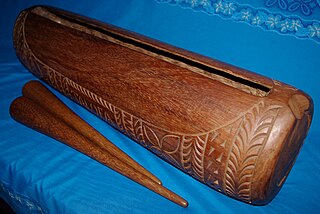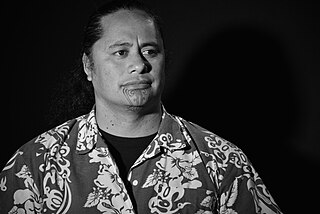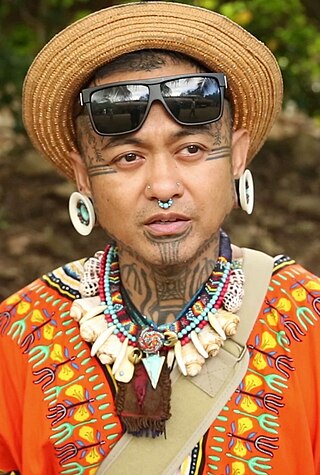Related Research Articles
In Tahiti and adjacent islands, the term Maohi refers to the ancestors of the Polynesian peoples.

The Pātē is a Samoan percussion instrument of Tahitian origin, named after the Samoan word for "beat" or "clap" "pulse". It is one of many Samoan log drum variants and is of the slit drum family, and therefore is also of the idiophone percussion family. It is made from a hollowed-out log, usually of Miro wood and produces a distinctive and loud sound. Different sizes of log drums offer different pitches and volumes, as well as striking the log drum in the middle or near the ends.

Tamaeva V or Temaeva V, formally Heimataura Tamatoa Tamaeva V, was the Arii vahine no Rimatara or queen of the island kingdom of Rimatara, an island within the larger Austral Islands archipelago, from 1892 to 1901. She served as regent for her predecessor Queen Tamaeva IV.

Tamaeva IV was the reigning queen of the Polynesian island of Rimatara who ruled from 1876 until her death in 1892. French sources refer to her as Temaeva, and one Australian newspaper called her Te Maere, while her tombstone in Rimatara gives her name as Tamaeva.
Marie Mariterangi, Marie Mariteragi, Marie Terangi or Marie was a singer, songwriter of Polynesian pop music, guitarist and ukulele player. She was born on May 3, 1926 in Hikueru in French Polynesia and died on April 27, 1971 in Papeete in French Polynesia.

Lynn Jaime Rapu Tuki is a Chilean promoter of the arts and traditions of the Rapa Nui People and head-teacher and founder of the Ma'aranui Cultural Academy and the Cultural Ballet Kari Kari. He is Cultural Ambassador of Asia-Pacific and has been Head of the Liaison Office of the National Council of Culture and the Arts.

Coco Hotahota was a French Polynesian dancer and choreographer who founded the Temaeva troupe in 1962. He greatly contributed to choreography for the dance ’Ori tahiti.
Jean-Claude Teriierooiterai was a French Polynesian linguist and anthropologist. An advocate of the Tahitian language, he was a member of the Tahitian Academy.
Tumata Robinson is a French Polynesian dancer and choreographer. She is the founder of the Tahiti Ora dance troupe, and cofounder of the 'Ori Tahiti Nui dance competition. She was the daughter of American sailor and Legion of Honour recipient William Albert Robinson.
Louise Kimitete was a French Polynesian choreographer, dancer and teacher of Tahitian dance.
Madeleine Teroroheiarii Moua was a French Polynesian dance troupe leader and major choreographer of Tahitian dance. She was the founder of the Heiva troupe. She was descended from the Tahitian royal family.
Kehaulani Chanquy is a French Polynesian dancer. She leads the Hitireva dance troupe, and runs the Arato’a dance school.
Catherine Puchon is a French Polynesian dancer, politician and Member of the Assembly of French Polynesia. She is a member of Tāpura Huiraʻatira.

Michel Toofa Pouira Krainer, known as Chief Miko is a French Polynesian speaker, sculptor, traditional navigator, musician, singer, customary chief and activist. He played a major role in the Polynesian cultural revival, particularly in the revival of Polynesian tattoos.

Jonathan Bougard is a French designer and documentary film director active in French Polynesia since 2005.

Elle Festin is an American tattoo artist of Filipino origin. In 1997 he created the Tatak ng Apat na Alon tribe, a transnational collective that popularized traditional Filipino tattooing around the world.
Tatak Ng Apat Na Alon Tribe or Mark of the Four Waves tribe in English, is a transnational collective made up of members of the Filipino diaspora who work to preserve the ancestral traditions of Filipino tattooing. It was founded in 1996 in Los Angeles by tattoo artist Elle Festin.
Cudjuy Patjidres, from the Paiwan ethnic group, is a traditional Taiwanese tattoo artist.

Heiva, the Wrath of the Gods (French: Heiva, la colère des dieux is a French documentary film written and directed by Jonathan Bougard, released in 2019.

Coco Hotahota Te Maeva is a French feature-length documentary dedicated to the dancer, choreographer, troupe leader and musician Coco Hotahota, the major artist of Polynesian dance. Directed by Jonathan Bougard, it was broadcast for the first time on television as a tribute to the choreographer the day after his death on the Polynesian channel TNTV.
References
- ↑ "Te Maeva, une troupe authentique depuis 57 ans". Polynésie la 1ère (in French). 2019-06-18. Retrieved 2024-02-20.
- ↑ Webmaster (2017-07-06). "N°118 – Temaeva fête ses 55 ans au marae Arahurahu" (in French). Retrieved 2024-02-20.
- ↑ Barrais, Delphine. "Fabien Dinard fait rayonner sa culture". TAHITI INFOS, les informations de Tahiti (in French). Retrieved 2024-02-20.
- ↑ Leyral, Mike (2019-07-12). "Temaeva, aux racines du Heiva". TNTV Tahiti Nui Télévision (in French). Retrieved 2024-02-20.
- ↑ Lynn, Frederiksen (2024). Dance Cultures Around the World. Human Kinetics. ISBN 9781492572329.
- ↑ VOD, Tahiti. "Aroha mai". Tahiti VOD (in French). Retrieved 2024-02-20.
- ↑ VOD, Tahiti. "Sacré Coco". Tahiti VOD (in French). Retrieved 2024-02-20.
- ↑ Film-documentaire.fr. "Horo'a, le don". www.film-documentaire.fr (in French). Retrieved 2024-02-20.
- ↑ Coco Hotahota Te Maeva (2020) | Documentary , retrieved 2024-02-20
- ↑ Coco Hotahota farereiraa (2022) | Documentary , retrieved 2024-02-20